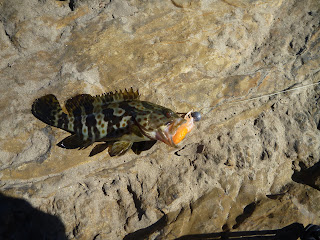There is nothing more rewarding when fishing then having the right lure in the right place and at the right time. While soft plastic fishing for flathead, lure, time and location are the three factors that can make the difference between not catching fish and that flathead of a lifetime.
My favourite tide for to fish an estuary can range from the last three hours of an outgoing tide, to 1 hour after the tide changes and starts coming in. This is purely because flathead are ambushing predators which camouflage themselves under the sand and wait till there food passes by, usually due to the drop in water height. Many people make the mistake that all the fish are feeding on the high tide and also make long and pointless casts past the feeding fish which are often at your feet.
 |
| A solid flathead taken on a soft plastic at Lowtide |
My mate and I were at our local estuary system, bright and early in the morning, just before the tide started pushing in. the general underwater landscape is sand with rocks spread throughout the creek bed. When fishing these snaggy areas I usually turn to my No.1 softplastic, the Storm Twitching Nipper.
In no time, after the first few casts, I had hooked up on a nice fish which appeared similar to a whiting as it darted through the water. The fish was landed on the sandy bank after making a few spectacular jumps and turned out to be a nice giant herring. These being uncommon at this spot but more likely found in the dreams of many saltwater fly fishermen. The fish was released without harm after a couple of quick pictures.
 Only a few casts later I tried to let the lure sink down between the rocks on the sandy bottom. As I twitched my little nipper and let it fall back down, the slightest tug pulled my line so I lifted my rod to hook the fish. At first it felt like the I had hooked into a solid rock until it zigzagged through the water and shot off towards the rocky wall. The fish put up a good fight pulling the line of my Okuma combo every time it raced towards the barnacle and oyster encrusted rocks. I eventually slid the fish into a shallow section where I used my Okuma Lip Grips to get a good hold on what turned out to be a sizable flathead.
Only a few casts later I tried to let the lure sink down between the rocks on the sandy bottom. As I twitched my little nipper and let it fall back down, the slightest tug pulled my line so I lifted my rod to hook the fish. At first it felt like the I had hooked into a solid rock until it zigzagged through the water and shot off towards the rocky wall. The fish put up a good fight pulling the line of my Okuma combo every time it raced towards the barnacle and oyster encrusted rocks. I eventually slid the fish into a shallow section where I used my Okuma Lip Grips to get a good hold on what turned out to be a sizable flathead. While in the lip grips, I supported her belly and took her over to out gear for a few quick pictures. The fish measured 60cm, was tagged and released with no dramas.
 |
| The Nipper munching flathead before being released. |
As the tide crept in and the number of bait fishermen turned up to feed the fish, more time passed between bites. A similar thing happened to me on the other side of the creek about 20 minutes later. I let the lure sink down and gave it a few sharp twitches. This time it resulted in a nice 50cm dusky flathead which was also tagged and released.
My mate finally caught on to the Storm Nipper concept and managed to land a nice little giant herring on the pink variety of the lure, after changing from hard body. I managed to hook up on a couple of small goldspot rockcod off a rocky ledge.
 |
| little cod like this will hit lures quite large for them |
My chosen tackle for this type of fishing is my Okuma graphite Travel rod and the Okuma Flame 30 reel spooled with Sufix Duraflex line.
 |
| Sufix Duraflex monofilament |
The little Storm Nipper proved it’s worth once again with a few great catches throughout the day. If you are one of those keen flathead anglers, or are new to the soft plastic revolution I suggest you get a packet of these for your tackle box as it just might catch that fish of a lifetime.




No comments:
Post a Comment